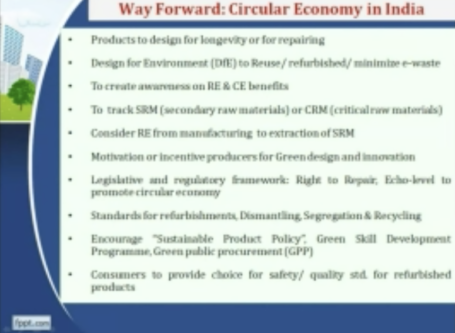
Picture credit: by Tyler Lastovich from Pexels
The third and last session of the inaugural day of the CII’s Virtual Waste to Worth Conference focussed on India’s e-waste landscape and addressed the status of India’s e-waste management ecosystem, challenges and potential paths for improvements, different aspects of e-waste related to technology, finance, EPR policies and regulations, formal and informal sector, business and PROs.
The session was moderated by Ms Ekta Narain – Co-founder & Director, Recykle, who began the session by highlighting the magnitude of the e-waste problem in India.
Dr. Sandip Chatterjee – Director, R&D, Ministry of Electronics and Information Technology, GoI made a special address on e-waste management in India and the government’s efforts to streamline it towards the goal of achieving a circular economy. Dr. Chatterjee reminded attendees that e-waste recycling is only a part of CE efforts and India needs to encourage product re-design to minimize total e-waste generation. He noted that while rules to mandate EPR in the e-waste sector exist in India, compliance is lacking. This is taking a heavy toll on the economy since valuable secondary raw materials including gold, copper etc are being lost in the process, according to Mr Chatterjee. He listed various policy initiatives to enforce better e-waste management in India including creation of more skilled manpower in e-waste recycling. “The government is trying to provide requisite skills to recyclers through the Green Skills Development Program.” Mr Chatterjee concluded by offering concrete recommendations on ways to manage e-waste better (see image below).

This was followed by an interactive discussion with industry experts. Asked about the emphasis in government guidelines regarding recyclers’ registered land area versus installed capacity, Mr Raman Sharma – Managing Director, Exigo Recycling Pvt Ltd said, “Entry-level barriers in e-waste recycling need to be created so that adequate amount of land becomes a key criteria to set up good recycling facilities.”
Lack of skills among engineers, inspectors, etc is another concern, according to Mr Sharma. “Specificity is lacking in terms of minimum requirements for recycling facilities,” he concluded. In response, Mr Chatterjee confirmed that efforts are underway to address this and a proposal has been made to the Niti Aayog on this.
On the subject of unit economics for e-waste recycling, Mr Jeevesh Kumar – CEO, Greenscape Eco Management Pvt Ltd, suggested fundamental changes that can help the sector. “Unit economics are varied. We need to create benchmarks for the future of this industry. E-waste needs to get industry status, for one. Second, recyclers must be assured that e-waste will to be delivered to their doorstep. For this, municipalities can help in facilitating collection. Electricity exemptions will also help, along with government subsidies for land acquisition. Tax exemption, collection incentives etc can help the formal recycling industry to further develop and prosper.
On a positive note, Mr Ravi Kumar Neeladri – CEO – Cerebra Integrated Technologies said that the scope for refurbished electronics in India is increasing post-pandemic. Yet, while India’s refurbishment requirements are increasing, there are manufacturing and supply chain issues. Import of spares is also on the rise, which must be addressed.
Asked whether EPR documentation should be standardized across brands, Ms Manjri Gopalan – Head – Regulatory Policy, Hewlett Packard said producers should have flexibility in formulating and documenting their EPR plans. Standardization at every stage is not practical since every brand caters to a different product category, Ms Gopalan added.
Mr Anil Chowdhary, Managing Director – Greenwaves spoke on the issue of integration of the informal sector into the formal e-waste system, which is currently ridden with challenges. A majority of the waste in India is collected by the informal, who lack formal training on how to scientifically recycle this waste. Since informal workers have good access for collection purposes, efforts can be made to channelise informal collections into the formal waste stream. Both sides can work together in a collaborative manner.
Jonathan Quinn, Founder – Smart Creative, UK spoke of the advantages of using mechanical methods in e-waste recycling. “There is great opportunity in e-waste segregation and processing. Collaboration in terms of e-waste collection and recycling services can also be established to streamline the process,” Mr Quinn said. Smart Creative offers a technology that involves a clean chemical recovery process and increases throughput and yield by using ultrasound to reduce the processing time considerably. With the use of ultrasonic agitation, the technology speeds up recovery period by up to 20 times.
Mr Sharma was optimistic about future opportunities in solar and battery waste recycling in India sector but felt that a lot more needs to be done to prepare for expected growth in the sector. Other panellists also highlighted some of the challenges facing the sector. Mr Kumar said, “Subsidies should be put to good use to enhance infrastructure for quality production of extracted metals and extracted commodities. They can help the economy immensely if applied wisely.”
Rueing the fragmented e-waste ecosystem in our country, Ms Narain said that small efforts can go a long way in improving the e-waste landscape. Ms Gopalan added, “One of the biggest challenges in EPR for e-waste remains changing consumer mindsets. Hoarding of electronics is a norm in India and a paradigm shift is possible only through extensive awareness campaigns.”
Another challenge is the misconception of shared responsibility. “For effective e-waste management, various stakeholders in the ecosystem need to do their bit. Even if one fails, the accountability should not be passed on to the producer, as is the current practise. Each stakeholder and its role should be defined which will help solve complex e-waste management problems in India,” she said. “While the efforts of PROs in bridging the gap between consumers and producers is laudable there is a long way to go. Leakages in the system have to be controlled and PROs should be monitored better by the CPCB, just like the producers. A neutral body needs to be established to monitor the activities of the various concerned agencies,” she said.
Mr Chowdhury agreed. Lack of transparency by PROs and knowledge of e-waste legislation is a big hurdle, according to him.
November 17 will witness panel discussions on three other relevant topics. Watch this space tomorrow for more on the proceedings.
To register for the conference and exhibition for free, click here.
Or visit: https://www.ciiwaste2worth.com/international-conference-2021.php?page=Conference



